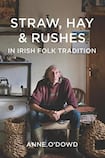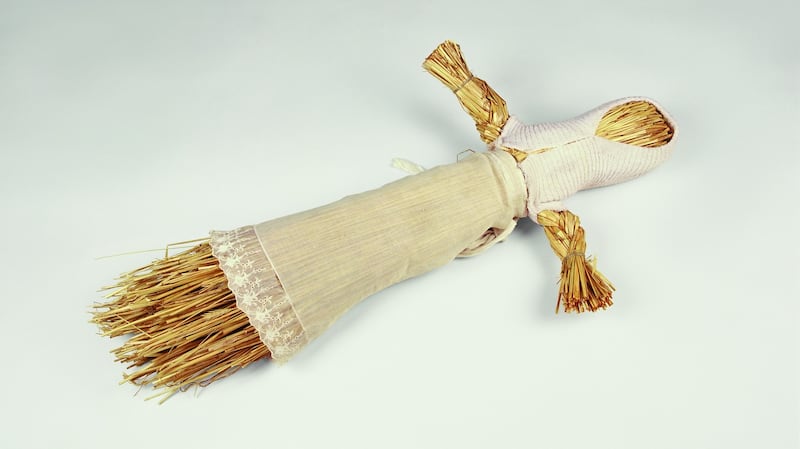
In 1975 the first BA degrees in folklore studies to be awarded in Ireland were conferred by University College Dublin. Anne O’Dowd was one of the most brilliant of those early folklore students, and soon after her graduation was given a position as assistant keeper in the folk life division of the National Museum of Ireland. Subsequently she took a doctorate in folklore. Her special area of interest has always been ethnography, or material folk culture, an area in which she is one of the world’s experts.
The director of the museum in the 1970s was Dr Tony Lucas. One of his great interests was straw. He realised he would not “get around to writing the book on straw”, and, before he died in 1986, he asked the young Anne O’Dowd to take on the work. “I agreed without hesitation.” The result of her generous promise was years of assiduous research and finally the magnificent book under review – a work in which love, loyalty, hard work and excellent scholarship are interwoven as perfectly as the straw which constitutes the raw material of some of the artefacts created by Irish country people.
The book surveys in detail the use of straw, hay and rushes as materials used in numerous ways: in constructing houses and outhouses, roofs, furniture, tools for housework, in farming and fishing, decoration, in drama, playing, religion and magic. O’Dowd’s sources are many, including early Irish literature and international literature, eg Shakespeare, but the main sources were the folklore manuscripts in the National Folklore Collection, UCD and the collections of the National Museum. Of particular relevance have been the questionnaires distributed throughout the country by the Irish Folklore Commission and the National Museum in 1958 and 1962, which bore the same understated, rhythmical and strikingly poetic title as this book: Straw, Hay and Rushes.

“To clutch at straws”; “the last straw”; “I don’t give a straw”: the centrality of straw in life is demonstrated by the plenitude of proverbs and proverbial expressions which refer to the material. We still use these expressions, but don’t often consider their origins – naturally.
Humblest plant of all
Perhaps the humblest plant of all is the rush, which grows on bad, wet land, and the book opens with a chapter devoted specifically to rushes. This section illustrates perfectly the impressive breadth of O’Dowd’s research. How were rushes used? They were spread on floors for insulation and decoration, sometimes mixed with aromatic flowers. On feast days, they were strewn on floors and outside houses, and in churches. And they were spread in honour of guests, as many formulaic expressions testify. O’Dowd quotes from responses to the 1962 questionnaire: “If I knew you were coming I’d have rushes for you”; “If I knew you were coming I’d shake green rushes for you.”
People all around Ireland remembered these expressions in 1962, testifying to the ubiquity of the practice in relatively recent times. O'Dowd follows her description of the uses to which rushes were put in Ireland in the 19th and 20th centuries with a look at much earlier sources. Medieval Irish texts refer frequently to the use of rushes, practically and ceremonially. So do many English sources. She cites several references to rushes by Shakespeare (who was a good documenter of folk life, and proverbs): "She bids you on the wanton rushes lay you down / And rest your gentle head upon her lap." (Henry IV)
From rushes and straw hundreds of things were made. St Brigid’s crosses, masks for folk plays, mummers, straw hats and costumes, harvest knots, chairs, hens’ nests, beehives, fishing nets, gloves, boots, leggings, hats, back baskets, head baskets, spancels (animal restraints), lamps, dolls, rattles, other toys and of course ropes and roofs. The uses to which straw was put were multiple.
We are familiar with thatched roofs – which we have so tragically allowed to all but vanish from our cultural landscape – and St Brigid’s crosses. But rushes were used to make swimming rings: “Simple swimming aids of lifebelts were made in several parts of Ireland as teaching aids or personal floats, and are similar to those made in many parts of the world.”
So, Irish children in the old days learned how to swim just like we do? Without plastic wings? They didn’t just figure it out, or drown? I don’t know why this came as such a surprise to me. It is not the only pleasant surprise in this wonderful book.
Dr Raghnall Ó Floinn, director of the National Museum, points out in his foreword that straw is of its nature perishable, so surviving artefacts are rarer than those made of durable materials. But a goodly number of objects have survived – thanks to the foresight of Tony Lucas, who collected many objects in the mid-20th century while it was still possible to get them. What will strike most of us is how attractive these items were – the beehive (just one survives), the hens’ nests, the mats, the dolls. And the more mundane things like headbands on which to rest baskets.
We tend to believe that as a people the Irish have traditionally had a stronger sense of verbal aesthetics and a less developed visual one, that we were better at storytelling and singing than at art or sculpture, because we didn’t have money for paint and brushes etc. But apart from anything else Anne O’Dowd’s book demonstrates the great craftsmanship that went into the manufacture of things created from the humblest of materials, and the stunning beauty of those creations.
This volume itself is an object of stunning beauty and will delight everyone – it is very accessibly written, and the illustrations are many and excellent. It provides an invaluable insight into the lifestyles of Irish people in the past: into their technical skills, their inventiveness and their aesthetic sense. They were smarter and more interesting than they are often given credit for. In many ways they were smarter than we are.
Gargantuan works of research
From a scholarly point of view, this book is invaluable. It joins an elect pantheon of gargantuan works of research which survey the most significant areas of Irish tradition – such as, to name a few, Maire Mac Neill's The Festival of L ughnasa, Patricia Lysaght's The Banshee, Daithi Ó hÓgáin's An File, Anne O'Dowd's Spalpeens and Tatie Hokers, a history of the migratory agricultural worker in Ireland and Great Britain. These are all big books based on years or decades of research, which provide invaluable overviews of key aspects of life – veering towards the descriptive rather than the theoretical, their longevity is assured. Theories change; evidence on the whole does not, especially evidence researched by scholars with high standards of accuracy, such as O'Dowd (and, one might add, the graduates of the Department of Irish Folklore in UCD in general.)
There are fewer of these eminently useful classics than one might suppose, and several crucial subjects have not been covered in the depth which they deserve, if a published history of Irish culture is a desideratum. But it takes time and much work to produce volumes of this kind. Two of the great books have been written by O’Dowd. What more need one say? Except perhaps this: she has made a lasting contribution to the sum of our knowledge about our country and the skills of its people. We should be very, very grateful.
Éilís Ní Dhuibhne is a writer and folklorist. She teaches creative writing at UCD










